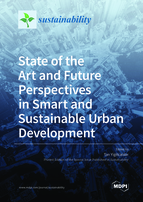State of the Art and Future Perspectives in Smart and Sustainable Urban Development
A special issue of Sustainability (ISSN 2071-1050). This special issue belongs to the section "Sustainable Urban and Rural Development".
Deadline for manuscript submissions: closed (31 October 2021) | Viewed by 91255
Special Issue Editor
Interests: smart technologies, communities, cities and urbanism; knowledge-based development of cities and innovation districts; sustainable and resilient cities; communities and urban ecosystems
Special Issues, Collections and Topics in MDPI journals
Special Issue Information
Dear Colleagues,
In the age of climate, disaster, and pandemic catastrophes, it is of the utmost importance to transform our cities into sustainable, resilient, robust, and livable ones. Simply, smart and sustainable urban development is critical to meet our growing needs for natural resources, industrial products, energy, food, transportation, shelter, and effective waste management, while conserving and protecting environmental quality and the natural resource base essential for future life and development.
This Special Issue will contribute to improving research and practice in smart and sustainable urban development by bringing an informed understanding of the subject to scholars, policymakers, and practitioners. This Special Issue seeks contributions—in the form of research articles, literature reviews, case reports, or short communications—offering insights into the smart and sustainable urban development by conducting in-depth conceptual debates, detailed case study descriptions, thorough empirical investigations, systematic literature reviews, or forecasting analyses. This Special Issue will be a repository of relevant information, material, and knowledge to support research, policymaking, practice, and transferability of experiences to address the urbanization and other planetary challenges.
The scope of the Special Issue—that compiles the cutting-edge work of researchers that investigate the state of the art and future perspectives in smart and sustainable urban development—includes the following broad areas, although other relevant topics will also be considered:
- Theoretical and conceptual underpinnings and analytical and policy frameworks of smart and sustainable urban development;
- Methodological and technical approaches for the evaluation and forecasting of smart and sustainable urban development;
- Technological progress, developments, and trials concerning the quadruple bottom-line development of smart and sustainable cities;
- Global best and good practice smart and sustainable urban development case investigations, demonstrations, and reports;
- Smart and sustainable urban development planning, design, applications, and governance models to deliver desired urban outcomes;
- Premises, pitfalls, implications, and impacts concerning the future of urbanization and smart and sustainable urban development.
Prof. Dr. Tan Yigitcanlar
Guest Editor
Manuscript Submission Information
Manuscripts should be submitted online at www.mdpi.com by registering and logging in to this website. Once you are registered, click here to go to the submission form. Manuscripts can be submitted until the deadline. All submissions that pass pre-check are peer-reviewed. Accepted papers will be published continuously in the journal (as soon as accepted) and will be listed together on the special issue website. Research articles, review articles as well as short communications are invited. For planned papers, a title and short abstract (about 100 words) can be sent to the Editorial Office for announcement on this website.
Submitted manuscripts should not have been published previously, nor be under consideration for publication elsewhere (except conference proceedings papers). All manuscripts are thoroughly refereed through a single-blind peer-review process. A guide for authors and other relevant information for submission of manuscripts is available on the Instructions for Authors page. Sustainability is an international peer-reviewed open access semimonthly journal published by MDPI.
Please visit the Instructions for Authors page before submitting a manuscript. The Article Processing Charge (APC) for publication in this open access journal is 2400 CHF (Swiss Francs). Submitted papers should be well formatted and use good English. Authors may use MDPI's English editing service prior to publication or during author revisions.
Keywords
The following is a list of relevant keywords for this Special Issue, although papers on other related subjects are also welcome:
- Smart and sustainable urban development policy, planning, design, and governance
- Smart and sustainable urban development goals, indicators, and frameworks
- Smart and sustainable cities, communities, districts, precincts, buildings, and homes
- Smart and sustainable urban infrastructures, services, amenities, and systems
- Smart and sustainable urban technologies, data, platforms, and structures
- Climate change, natural disasters, pandemics, social inequality, and urbanization challenges
- Post-Anthropocene, post-capitalist, post-pandemic, post-disaster, and future living
- Artificial intelligence, blockchain, sensors, internet-of-things, and autonomous vehicles
- Green technologies, virtual reality, augmented reality, robotics, domotics, and digital twins






